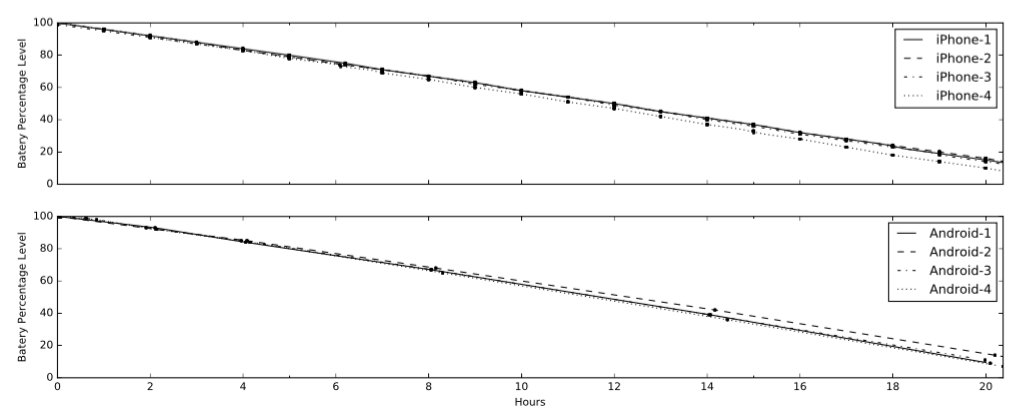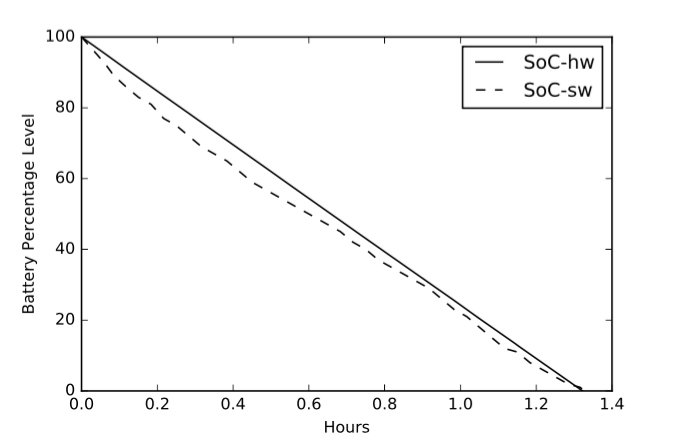Introduction
In the past decade, the rich set of sensors embedded in modern smartphones has inspired much research into context-aware applications through continuous mobile sensing. Given the strict power budget on mobile phones, it has become a high priority for researchers to implement energy efficient sensing algorithms. Our survey shows that most researchers rely on external hardware power monitors to evaluate the power drain of mobile sensing applications. External hardware power monitors not only require direct access to the phone’s battery, but also limit the mobility of testing and prohibit analysis on direct power versus accuracy trade-off. To overcome these limitations, we propose a software-based power monitoring technique that is easy to use and enables power monitoring of smartphones in the wild. With extensive testing, we show that this approach is a valid and effective way to evaluate power usage on both Android phones and iPhones.
Literature Survey
To gain a better understanding of approaches employed in academia for power evaluation of mobile sensing applications, we looked at the papers published at the two top conferences on mobile computing (MobiSys and SenSys) for the past 5 years and studied papers that utilized continuous sensing and reported power evaluation of their applications. The different techniques are summarized in Table [tab:summary-techniques].
| Mobile Sensing Applications | Power Evaluation Technique |
|---|---|
| Caloric expenditure of bicyclists [1] Automatic labeling of transit stations semantics [2] |
PowerTutor: model-based power estimation app |
| Indoor/outdoor detection [3] Bus arrival time estimation [4] |
Exhaustive battery run-down tests |
| Transportation mode detection [5] Indoor/outdoor detection [6] Driving routes detection [7] |
Simple power model: built offline fordifferent components |
| Device interaction [8] Transportation mode detection [9] Hotword detection [10] Meeting membership detection [11] |
External power monitor: power measurement of the whole design. |
PowerTutor [12] is a standalone power profiling application that was developed at the University of Michigan back in
- This tool only gives accurate absolute power measurements on three phone models and it has not been updated in three years. On the other hand, exhaustive battery run-down tests give a good estimation of whole system power consumption, but are time-consuming.
A majority of the papers we surveyed use a hardware power monitor on Android phones with removable batteries. However, as of 2016, popular smartphone manufacturers like Samsung and Lenovo have adopted non-removable batteries for a sleeker and more robust design. Connecting an external power monitor to such a phone is both challenging and risky because it requires manually disassembling the back of the phone.
We also observed from the literature survey that data used for studying accuracy is often collected in the wild, where phones are carried throughout people’s daily activities, despite the fact that most power measurements are gathered in well-controlled experimental settings. This practice persists even for mobility-based detection such as indoor/outdoor detection and transportation mode detection. The segregation of accuracy and power analysis hinders a more thorough understanding of the relationship between these two indispensable design goals. We think the dearth of direct accuracy versus power trade-off analysis can be largely attributed to limits on mobility imposed by bulky external hardware monitors.
Proposed Methodology
Both Android and iOS provide a software API that returns battery level readings. The technical term for battery percentage is “State of Charge” (SoC), denoting the percent of energy remaining in a phone battery [13], and therefore should be proportional to power draw from the battery. Our proposed software-based power monitoring tool records the change in SoC and enables easy comparison of power drain on different continuous sensing mobile applications. For example, to compare power usage of two designs, we will use two phones of the same model, same OS version and same baseline applications installed. Next, each phone will run one of the designs and we can then compare the change in their respective SoC over time. One big advantage of the software-based power monitoring tool is that it does not require access to phone battery, making it compatible with newer phones with non-removable batteries. Furthermore, the fact that our methodology is purely software based means that there is no limitation on phone mobility during evaluation. Therefore, data related to power and various sensors can be collected simultaneously, allowing for direct analysis on the trade-off between accuracy and power.
Implementation
The battery monitoring tool is currently implemented as part of a location tracking app called E-mission [14] that is available for download for both iOS and Android devices. It periodically reads battery percentage (SoC) from the software battery API, stores it locally, and pushes it to a remote server when connected to the Internet. Data saved on the server can be easily pulled to a local machine for analysis.
Analysis
To evaluate the accuracy of SoC reported through software, we conducted various experiments on four iPhone 6 and four Nexus 6 devices to examine the behavior of software-based power monitoring on both platforms.
To emulate a constant workload, we turn on high accuracy location tracking with GPS on all 8 phones while they are placed in stationary. Figure [fig:battery-drain] depicts the battery drain for a full discharge. The change in the SoC fits well to linear models with a low root mean square error of 0.4285 (iPhone) and 0.343 (Android). The average battery drain rate (percent drop/hr) also exhibits high consistency across phones with a small standard deviation: 0.126 for iPhones, and 0.136 for Android.

Figure 1: Battery drain across phones (full discharge cycle)
We also measured voltage and current naively for a Galaxy Nexus device for a full discharge cycle using two multimeters while the phone was set to play a video with a white screen on repeat. Figure [fig:sw-hw] shows the comparison between hardware-based and software-based SoC. The average battery drain rate from the sw-reported SoC was found to be fairly accurate with a small % error of 4.27%.

Figure 2: SW vs HW Measured state of charge
We ran battery monitoring at various frequencies on identical phones and compared with a baseline phone. We observed that periods longer than 30m have negligible battery drain overhead.
These results collectively demonstrate the accuracy and potential of software-reported SoC. They justify software-based power monitoring as a valid technique for studying power behavior of continuous sensing mobile applications.
Conclusion
Given the limitations of existing power monitoring techniques and the shift towards non-removable battery in the mobile industry, our proposed technique can help to simplify the power monitoring process and enable researchers to evaluate their designs in the wild for a better understanding of their power consumption. For future work, we would like to build a standalone battery percentage monitoring app with configurable settings allowing easier adoption of this technique.
Acknowledgement
This work was funded by the NSF SUPERB Program. I would like to thank my mentor K. Shankari, Jonathan Fürst, and Professor David Culler for the tremendous amount of support and guidance that went into making this project possible.
References
-
Andong Zhan, Marcus Chang, Yin Chen, and Andreas Terzis. Accurate caloricexpenditure of bicyclists using cellphones. In Proceedings of the 10th ACMConference on Embedded Network Sensor Systems, pages 71–84. ACM, 2012.
-
Moustafa Elhamshary, Moustafa Youssef, Akira Uchiyama, Hirozumi Yamaguchi, and Teruo Higashino. Transitlabel: A crowd-sensing systemfor automatic labeling of transit stations semantics. In Proceedings of the 14th Annual International Conference on Mobile Systems, Applications, and Services, pages 193–206. ACM, 2016.
-
Pengfei Zhou, Yuanqing Zheng, Zhenjiang Li, Mo Li, and Guobin Shen. Iodetector: a generic service for indoor outdoor detection. In Proceedings of the 10th ACM Conference on Embedded Network Sensor Systems, pages 113–126. ACM, 2012
-
Pengfei Zhou, Yuanqing Zheng, and Mo Li. How long to wait?: predicting bus arrival time with mobile phone based participatory sensing. In Proceedings ofthe 10th international conference on Mobile systems, applications, and services, pages 379–392. ACM, 2012.
-
Samuli Hemminki, Petteri Nurmi, and Sasu Tarkoma. Accelerometer-based transportation mode detection on smartphones. In Proceedings of the 11th ACM Conference on Embedded Networked Sensor Systems, page 13. ACM, 2013.
-
Valentin Radu, Panagiota Katsikouli, Rik Sarkar, and Mahesh K Marina. Asemi-supervised learning approach for robust indoor-outdoor detection with smartphones. In Proceedings of the 12th ACM Conference on Embedded NetworkSensor Systems, pages 280–294. ACM, 2014.
-
Sarfraz Nawaz and Cecilia Mascolo. Mining users’ significant driving routes withlow-power sensors. In Proceedings of the 12th ACM Conference on Embedded Network Sensor Systems, pages 236–250. ACM, 2014
-
Zheng Sun, Aveek Purohit, Raja Bose, and Pei Zhang. Spartacus: spatially-aware interaction for mobile devices through energy-efficient audio sensing. In Proceeding of the 11th annual international conference on Mobile systems,applications, and services, pages 263–276. ACM, 2013.
-
Kartik Sankaran, Minhui Zhu, Xiang Fa Guo, Akkihebbal L Ananda,Mun Choon Chan, and Li-Shiuan Peh. Using mobile phone barometer forlow-power transportation context detection. In Proceedings of the 12th ACM Conference on Embedded Network Sensor Systems, pages 191–205. ACM, 2014.
-
Li Zhang, Parth H Pathak, Muchen Wu, Yixin Zhao, and Prasant Mohapatra. Accelword: Energy efficient hotword detection through accelerometer. In Proceedings of the 13th Annual International Conference on Mobile Systems, Applications, and Services, pages 301–315. ACM, 2015.
-
Wai-Tian Tan, Mary Baker, Bowon Lee, and Ramin Samadani. The sound of silence. In Proceedings of the 11th ACM Conference on Embedded Networked Sensor Systems, page 19. ACM, 2013
-
Z Yang. Powertutor-a power monitor for android-based mobile platforms. EECS, University of Michigan, retrieved September, 2:19, 2012
-
Mohammad Ashraful Hoque, Matti Siekkinen, Kashif Nizam Khan, Yu Xiao, and Sasu Tarkoma. Modeling, profiling, and debugging the energy consumption of mobile devices. ACM Computing Surveys (CSUR), 48(3):39, 2016.
-
K. Shankari. E-mission: https://e-mission.eecs.berkeley.edu, 2016.